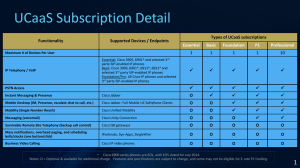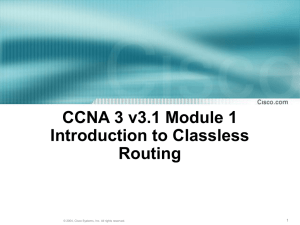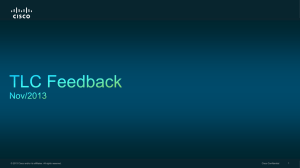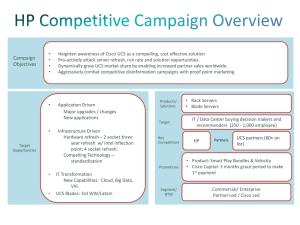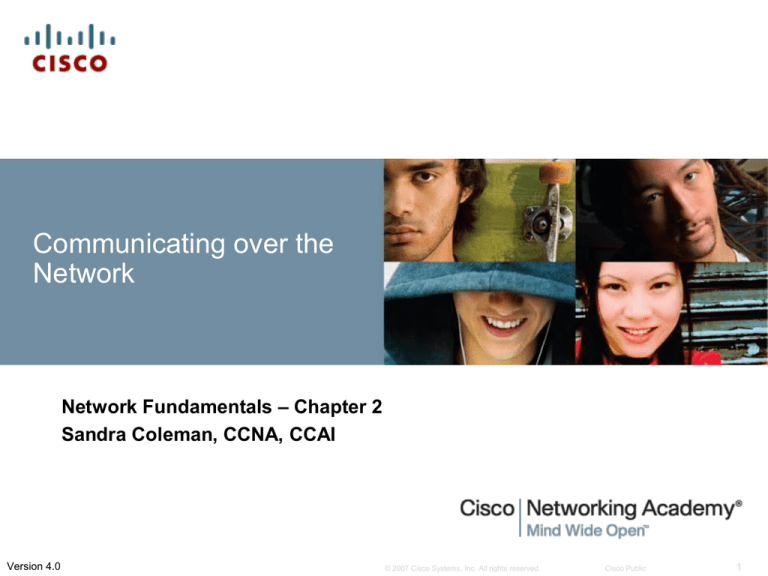
Communicating over the
Network
Network Fundamentals – Chapter 2
Sandra Coleman, CCNA, CCAI
Version 4.0
© 2007 Cisco Systems, Inc. All rights reserved.
Cisco Public
1
Objectives
Describe the structure of a network, including the
devices and media that are necessary for successful
communications.
Explain the function of protocols in network
communications.
Explain the advantages of using a layered model to
describe network functionality.
Describe the role of each layer in two recognized
network models: The TCP/IP model and the OSI
model.
Describe the importance of addressing and naming
schemes in network communications.
© 2007 Cisco Systems, Inc. All rights reserved.
Cisco Public
2
Network Structure
Three elements of communication
• Message source
• The channel
• Message destination
– Data or information networks capable of carrying many different
types of communications
© 2007 Cisco Systems, Inc. All rights reserved.
Cisco Public
3
How are messages communicated?
– Data is sent across a network in small “chunks” called segments – known as
segmentation
– Multiplexing – describes the process of interleaving multiple digital data
streams into ONE signal (see example in online curriculum 2.1.2)
– It increases the reliability of network communications
– Disadvantage is the amount of encapsulation that must occur with every
segment, especially for large amounts of data!
© 2007 Cisco Systems, Inc. All rights reserved.
Cisco Public
4
Network Components
• Hardware (includes devices and media)
• Software (services and processes)
© 2007 Cisco Systems, Inc. All rights reserved.
Cisco Public
5
End Devices
– End devices form interface with human network &
communications network
– Originate data flow!
– Examples: computers, printers, VoIP Phones,
cameras, cell phones, etc.
– Commonly referred to as hosts (source or destination
of a message)
– Each host has an address that will identify it on the
network
– Role of end devices:
• Client (software installed so they can request & display info from the
server)
• Server (provide information and services to other hosts)
• Both client and server
© 2007 Cisco Systems, Inc. All rights reserved.
Cisco Public
6
Intermediary Devices
–Role of an intermediary device
• Examples: Hubs, switches, access points, routers,
modems, firewalls, etc.
• Provides connectivity and manages data flows
across network
• Works behind the scenes
• Determines the path data will travel to get from
source to destination
• Knows all the paths that exist
• Informs other like devices about errors or
communication failures
• Retimes & retransmits signals as necessary
© 2007 Cisco Systems, Inc. All rights reserved.
Cisco Public
7
Network Media
– this is the channel over which a message travels
– Encoding is different for each type, i.e. electrical
impulses, light pulses, wave patterns
© 2007 Cisco Systems, Inc. All rights reserved.
Cisco Public
8
Network Types
Local Area Networks (LANs)
– A network serving a home, building or campus is considered a
Local Area Network (LAN)
– Single geographic area, usually a common organization
– Administered by a single organization
– Provides network services to a common organization
© 2007 Cisco Systems, Inc. All rights reserved.
Cisco Public
9
Network Types
Wide Area Networks (WANs)
– LANs separated by geographic distance are connected by a
network known as a Wide Area Network (WAN)
– Be able to identify a LAN and a WAN given a similar diagram
© 2007 Cisco Systems, Inc. All rights reserved.
Cisco Public
10
Network Types
Define the Internet
– The internet is defined as a global mesh of interconnected
networks
© 2007 Cisco Systems, Inc. All rights reserved.
Cisco Public
11
Network Symbols – be able to recognize
© 2007 Cisco Systems, Inc. All rights reserved.
Cisco Public
12
Function of Protocol in Network Communication
– A protocol is a set of predetermined rules
– Implemented in software that is loaded on each host and
network device
– View them as a stack – from low to high in a hierarchy
– Outline the functions necessary to communicate between
layers
© 2007 Cisco Systems, Inc. All rights reserved.
Cisco Public
13
Network Protocols
– Network protocols are used to allow devices to communicate
successfully
– Protocols agree on structure of message (specific to PDU’s)
– Protocols agree on the process of sharing, error handling, and
termination procedures – all functions necessary for
communication
– Require layer dependent encapsulations
© 2007 Cisco Systems, Inc. All rights reserved.
Cisco Public
14
Protocols and Industry standards
– A standard is a process or protocol that has been endorsed by
the networking industry and ratified by a standards organization
– Ensures all protocols (open or proprietary) will work together
– IEEE (Institute of Electrical and Electronic Engineers)
– IETF (Internet Engineering Task Force)
© 2007 Cisco Systems, Inc. All rights reserved.
Cisco Public
15
Function of Protocol in Network Communication
Examples of Protocols
© 2007 Cisco Systems, Inc. All rights reserved.
Cisco Public
16
Function of Protocol in Network Communication
Technology independent Protocols
– Many diverse types of devices can communicate using the
same sets of protocols
– This is because protocols specify network functionality, not the
underlying technology to support this functionality
© 2007 Cisco Systems, Inc. All rights reserved.
Cisco Public
17
Layers with TCP/IP and OSI Model
Benefits of using a layered model
•
•
•
•
Assists in protocol design
Fosters competition (different vendors can work together)
Changes in one layer do not affect other layers
Provides a common language
© 2007 Cisco Systems, Inc. All rights reserved.
Cisco Public
18
Layers with TCP/IP and OSI Model
Away
Know the
layers in order!
Pizza
Sausage
Throw
Not
Do
Programmers
© 2007 Cisco Systems, Inc. All rights reserved.
Cisco Public
19
Layers with TCP/IP and OSI Model
TCP/IP Model – created in early 1970s – KNOW what
each layer is responsible for!
Open Standard
© 2007 Cisco Systems, Inc. All rights reserved.
Cisco Public
20
Layers with TCP/IP and OSI Model
Protocol data units (PDU) and encapsulation
PDUs are
SPECIFIC to each
layer!
Know PDUs at
EACH layer!
© 2007 Cisco Systems, Inc. All rights reserved.
Cisco Public
21
Key functions of encapsulation
Ensure that data pieces get from sending to receiving
device
Ability to re-assemble the data packets correctly
Ability to identify data packets that belong together with
the same communication package
© 2007 Cisco Systems, Inc. All rights reserved.
Cisco Public
22
Comparing TCP/IP and OSI Model
Know these layers and how they compare between the
two models
© 2007 Cisco Systems, Inc. All rights reserved.
Cisco Public
23
Addressing and Naming Schemes
Explain how labels in encapsulation headers are used
to manage communication in data networks
© 2007 Cisco Systems, Inc. All rights reserved.
Cisco Public
24
Addressing and Naming Schemes
Describe examples of Ethernet MAC Addresses, IP
Addresses, and TCP/UDP Port numbers
© 2007 Cisco Systems, Inc. All rights reserved.
Cisco Public
25
Addressing and Naming Schemes
Think about a computer that has only one network
interface on it. All the data streams created by the
applications that are running on the PC enter and leave
through that one interface, yet instant messages do not
popup in the middle of word processor document or email showing up in a game.
This is because the individual processes running on the
source and destination hosts communicate with each
other. Each application or service is represented at
Layer 4 by a port number.
© 2007 Cisco Systems, Inc. All rights reserved.
Cisco Public
26
Things to do NOW!
Demonstrate tracert
Demonstrate packet tracer…how to set up a network
Map them a drive to Public…
© 2007 Cisco Systems, Inc. All rights reserved.
Cisco Public
27
Ch. 2 is Finished!
Homework – due on
test day!
Study Guide
p. 34 – Matching (table
2-1 & 2-2)
p. 35-36 – Matching
(table 2-3 & 2-4)
p. 37-38 – Matching
(table 2-5 & 2-6)
Labs & Skills Integration
•Lab 2-1 (Do this on PT 2.6.1.2,
pg. 48 in lab book- I have the files
from the CD loaded on public)
•Ch. 2 Test will be on Tuesday
Sept. 5 or Wed. Sept 6, 2012
•Online Test – Must be taken by
Packet Tracer Activities in midnight on Sunday September 2,
the textbook
2012. I will NOT turn it on again!
2.2.4.2 (pg. 44)
2.4.8.2 (pg. 54)
© 2007 Cisco Systems, Inc. All rights reserved.
Cisco Public
28






